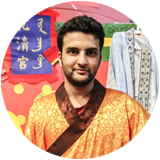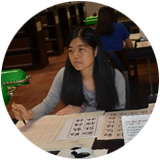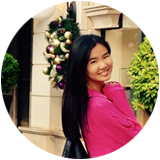
This exhibition features more than 30 pieces of calligraphy, mostly done by students with no previous experience in calligraphy. The students focused on how a single Chinese character evolved, on proverbs from fables, and words used on blessings. We are also honored to display the artworks done by members of the newly established student calligraphy club, faculty members including Prof. Man Kim Fung, Prof. Cheng Pei-kai, Prof. Horace Ip, and Dr. Sze Tsz Ching, friend of CityU
We cordially invite you to share the joy of this unique cultural heritage with us:
Exhibition Period: 1 December 2015 to 30 June 2016
Exhibition Venue: exhibition area, 2/F, Run Run Shaw Library
 |
WANG, Tianyu (Chinese) |
| Department of Mathematics | |
| I started to learn calligraphy from the famous female calligrapher HU Zhao Xia since young, and passed Grade 10 in the national calligraphy examination. For me, calligraphy is not only a technique, but also a deep character in one’s soul. In spare time, I like to practice different forms of calligraphy, experiencing the unique charms behind each form. | |
 |
HARILELA, Jayant (Indonesian born Indian) |
| Department of Mechanical and Biomedical Engineering | |
| My mind becomes tranquil when I learn Calligraphy. The beautiful Chinese characters represent the natural forms of life and I consider it a form of art. It is wonderful to witness how a brush with ink is able to create so much value and leave an impression on a blank piece of paper. In my personal opinion, calligraphy extends to more than just writing Chinese characters, It is a way of life: Create an impact on the world with every stroke you make. | |
 |
HITZERMAN, Richard (Dutch) |
| Department of Business | |
| Chinese calligraphy is a truly fascinating facet of the Chinese culture for several reasons. This is not only true because every separate character constitutes a small piece of art. It is also because ancient texts may still reveal knowledge to us that it is very much relevant today. Attending the calligraphy class at CityU provided me with insight into the valuable tradition of Chinese calligraphy and really added to the experience I had here in Hong Kong. During the weekly sessions, I have met interesting people and the discussions about the cultural/historical differences between China and my home country were both enriching and exciting. | |
 |
WAN, Hiu Tung Crystal (Chinese) |
| School of Law | |
| The amazing thing about practicing Chinese Calligraphy is that it brings you to a peaceful world of your own. Free from hustle and bustle, you can have a chance of re-adjusting yourself for new challenges in life. | |
 |
MOK, Yim To (Chinese - Hong Kong) |
| Department of Information Systems | |
| I learnt how to be patient and slow down my pace when practicing Chinese calligraphy. During the first lesson, I put half the character out of the box because I didn't think before I wrote. Calligraphy not just taught me "to think before act", but I can also achieve a relaxed and peaceful mental state throughout the process. | |
 |
LO, Wai Yin, Jenny (Chinese - Hong Kong) |
| Accountancy | |
| It has been a very long time since the last time I sit down and do Chinese calligraphy. Chinese calligraphy in my mind is a precious traditional art that requires high degree of preservation. The deep meanings in every stokes and the constructions of every words are well designed which make every single word a beautiful artwork. Even though our mother language is Chinese, it is still hard for us to master calligraphy. However, it is always worth while to understand more of your own culture. Also, I highly recommend people who are interested in Chinese to take a glimpse on Chinese calligraphy, it surely can give you a better knowledge of beauty of Chinese. | |
 |
SURJADI, James Utama (Indonesian) |
| Drawing has been my hobby for as long as I can remember. I initially joined the Chinese Calligraphy workshop as I wanted to learn a new kind of art, using a brush and ink, instead of just pencil. In the first class, I learned two different styles of writing, which were the regular and clerical script writing. I was impressed by the amount of attention and detail that I have to put into each stroke in order to create a simple character. Although it was a little frustrating at first, as I can’t seem to control the brush like I wanted to, I gradually came to enjoy it. It was gratifying when I realized I had been improving and began to have more control using the brush, despite knowing that I still have ways to go. I am glad to have gained an insight of Chinese Calligraphy, learning it has been a delightful and worthwhile experience. | |
 |
SHEN, Li (Chinese) |
| Department of Media and Communication | |
| The most important thing I learnt from Chinese calligraphy is to concentrate on completely what you are doing. When you are distracted, the strokes will not be as horizontal or vertical as expected. Although I write not so well, I can appreciate those calligraphy masterpieces after learning this course. Besides, I am very grateful for all the working staffs and teachers for holding this workshop. It's so nice of them to be patient and warm to us. | |
 |
WU, Wan Kit (Chinese - Hong Kong) |
| Department of Accountacy | |
| Practicing Chinese calligraphy is a good way for me to keep calm and relax from the noisy world. | |
 |
SINGH, Shaurya Pratap (Indian) |
| School of Law | |
| Chinese calligraphy gave me a fine introduction to the heart of Chinese culture. The characters amazed me by their beauty and depth of meaning. Since I am new to the Chinese language, calligraphy was my first introduction to the language. The characters are like poetry in motion, each is unique and when drawn correctly gives immense satisfaction and aesthetic pleasure to the observer. In calligraphy characters have a life like quality as they are drawn with energy and feeling of the person with the brush. There are two techniques the businesslike clerical style and the informal regular script, the first makes for elegant formal expression and the second an animated natural flow, in my experience the practice of calligraphy enhances the creative and spiritual qualities of a person. As a Buddhist Monk once said, Writing calligraphy is a practice of meditation. | |
 |
COSTA, Tomas (Brasilian) |
| College of Business | |
| It was a very enriching experience, even for a foreigner like myself who had never been in touch with any sort of writing that wasn't a Roman writing. I had just started taking Mandarin lessons and been introduced to the "beautiful way" of writing Chinese, but this calligraphy workshop took it a step further and I was able to fully appreciate the richness of the culture and how beautiful and difficult it is to write! The people conducting the workshop were very knowledgeable and I highly appreciated the little souvenirs and how everything was always well prepared and ready! | |
 |
LAPOUS, Robin (French) |
| College of Business | |
| This course was really enjoyable. Chinese calligraphy appears to be very demanding, requiring a high level of concentration as well as a decent amount of practice. On days when I felt tired, I could barely do a proper stroke… but managing to draw a character properly also feels really great! Also greatly surprising was the fact that everyone could visibly express his or her personality through calligraphy, despite the great number of rules of the discipline. CityU’s staff was very cheerful, passionate and dedicated and the quality of the equipment provided was really outstanding. Not to mention Uncle Ben’s very inspirational demonstrations and enthusiasm. If you’d like to enjoy a rewarding and meditative experience you should definitely give Chinese calligraphy a try! | |
 |
WONG, Chun Wan (Chinese - Hong Kong) |
| Department of Asian and International Studies | |
| Chinese calligraphy should be a significant culture and I will feel proud if I can write those words look well. However there are lesser and lesser people learn calligraphy in Hong Kong so I took this chance to learn it. At first, I felt exciting to write the word since my last time to use my brush was in my primary school. In the lesson, the teacher really put a lot of effort to teach us and helped us to improve. I am quite impress when I wrote those words better and better. In the last lesson, my teacher wrote me words which I prefer for present and I am so thank you for that. It is a great chance for me to learn Chinese calligraphy and I will remember this experience. When I was writing those words, I felt clam and relax. After writing the words, I felt joyful and I love this feeling. | |
 |
TONG, Weisen (Chinese) |
| School of Creative Media | |
| I came to learn Chinese calligraphy for releasing myself and learning Chinese culture initially. After the course, I made a lot of friends and knew how to distinguish and write the regular and clerical style. Warm welcome and free talk here also gave me chances to share and ask everything I like. Because teachers more likely our friends, they guided patiently. For students, fortunately, at the very beginning and at an end of the course, everyone received a souvenir from teachers. If you want to know what it is, join the course! | |
 |
LUK, Renza (Chinese) |
| Department of Information System | |
| I learnt Chinese calligraphy when I was in primary school. I never pick up ink brush again since then. This 6 lessons Chinese calligraphy class give me an opportunity to recall and refresh my memory on Chinese calligraphy. At the beginning, I even could not draw a proper horizontal stroke nor a vertical stroke. They were in curves. Luckily, the class gave a Chinese calligraphy practicing set to each student and I could practice the basis strokes at home. I love that practicing set very much. It uses water instead of ink. The “paper” is very special. It can be reuse many times. I did not need to change paper. Although the feeling in writing on this “paper” is different from the feeling in writing on paper which is designed for Chinese calligraphy, it provides a really good way in practicing the strokes.In addition, the class last approximately 1.5 hours. Within this 1.5 hours, each student only concentration on practicing Chinese calligraphy. This gives a precious opportunity for us to just work on one thing - Chinese calligraphy in a very traditional Chinese decorated environment.Teaching are mainly by videos and supplemented with some live demos by tutors. It will be even better if there can have live demo in each lesson. | |
 |
OU, Huiru (Chinese) |
| Department of Linguistics Translation | |
| It's been a while before i practice Chinese calligraphy again. Although it costs a lot of time and it is difficult to write well, i still regard it as an effective way to release pressure. May i remind you, when practicing, the slower the better! | |
 |
CHANG, Hua (Chinese) |
| Department of Chinese and History | |
| Calligraphy made me very meticulously in practice and it cultivated my patience very much. Thanks to the kind guidance of professor CHEN, and I will apply calligraphy spirits in my life. Since ancient times calligraphy of China has been thought meaningful activities,which can improve your mood and make your mind healthier. Through the workshop I know the art of calligraphy provides a whole set of terms of aesthetic appreciation which we may consider as the bases of Chinese notions of beauty. So as a Chinese especially a student who study in Chinese, I have responsibility to learn calligraphy well and spread it out. | |
 |
ENG, Peter |
| Hong Kong Baptist University | |
| I joined this workshop simply to relax after work, and it was indeed fun. But I also discovered a way of thinking and learning that is quickly receding in our digital age. Calligraphy is deliberate, purposeful, and focused. You must dip the brush into the ink carefully -- not dry, not drippy. You must think about where to place the character on the page, how it aligns with the white spaces and with other characters. You must think about the order of strokes, the thickness and length of each stroke relative to the other strokes, how much pressure to exert for each stroke, whether that stroke should be more straight-solid or cursive. As you write, you see each stroke building, step by step, the structure and meaning of the whole character. And completion of all the characters revealed a time-honored philosophy to ponder because this workshop focused on writing traditional sayings about how we should approach our individual and communal lives. This creative process is not just contemplative, but also very physical. In regular writing, you use only your fingers and wrist. I’m sure I wasn’t doing it quite properly, but with calligraphy I had to apply all the muscles of my arm and shoulder, even my neck. Like meditation, calligraphy practice inculcates deliberation, purpose and focus in our daily lives. But I also found it a very effective way of re-learning the Chinese vocabulary that I lost while growing up in the U.S. By combining mental focus, muscle memory and art, calligraphy taught me new words much faster than trying to memorize the words or repeatedly writing them with a pen. Could this approach be applied to other types of learning, other subjects?I thank our teacher Mr. Chan, as well as Alice Zhao, Sandy Lee and Steve Ching of CityU library, and volunteers Wendy Ng and Stella Lee, for being so hospitable in letting me, an outsider, join the workshop. They helped me to discover. | |
 |
LIU, Yizhen |
| Department of Information System | |
| 中國是個文明古國,上下五千年的歷史,賦予了我們浩淼淵博的文化。其中,書法便是我們中國特色的一種文化,它能夠使我們了解中國傳統的文化特點,增加傳統文化知識,為現在的學習打下堅實的基礎,更重要的是深厚的文化底蘊能讓我們的心靈受到熏陶,情操得到陶冶;它或端莊、或飄逸、或狂野的書法形式能給我們一種美的享受,就連很多外國朋友都非常喜歡我國的書法藝術。書法之美,源於漢字之美,漢字賦予了書法內涵之美。“昔在黃帝,創制造物。有沮誦、倉頡者,始作書契,以代結繩,蓋睹鳥跡以思也。因而遂滋,則謂之字。”漢字的創造,演變和發展是書法藝術發展的基礎,也是中國五千年璀璨文化的縮影;同時,書法又賦予了漢字無限生動的形式之美。書法的橫、豎、撇、捺、點、勾、提和折是對漢字形式的藝術升華。衛夫人有雲:“點畫如高峰墜石,磕磕然實如崩也;橫畫如千裡陣雲,隱隱然其實有形;豎畫如萬歲枯藤;撇畫如陸斷犀像;捺畫如崩浪雷崩;斜勾如百鈞弩發;橫折如勁弩筋節;每為一字,各像其形,斯造妙矣,書道畢矣。” 當然書法之美不單單只是其在楷、隸、行,草書等字體形式變化之美,書法之於其喜好者,更是一次難得的身心修行的歷練。書法是一門深奧的藝術,不是一朝一夕就可以學成的。要想練得一手好的書法,需要經受住時間的砥礪和長期反復地練習。古代著名書法家王羲之教授其子王獻之書法時說道,需練完十八大缸墨水,方才可領悟書法之義。書法練習需靜心,忌急功近利,“觀千劍而後識器,操千曲而後知音”,只有鍥而不舍、持之以恆,才能有所領悟。書道如此,做人亦是如此。懶惰懈怠不可有,浮躁媚俗更不可取,為書之人需有真性情,真修養和真襟懷。書法之於我們的,是一種做事認真,做人踏實的品格,更是一種繼往開來、勇於創新的氣魄。書法之路漫漫,願我們一起努力。 |